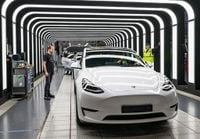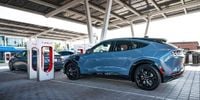After nearly two decades of shaping the American auto landscape, the federal electric vehicle (EV) tax credit—long a centerpiece of U.S. green policy and auto industry strategy—has reached its end. As of September 30, 2025, the $7,500 clean-vehicle credit, introduced to jump-start the domestic EV market, officially expired following legislation signed by President Donald Trump and passed by GOP lawmakers. The final days of the program saw a surge in consumer activity, with buyers scrambling to sign deals and lock in thousands of dollars in savings before the curtain fell.
The numbers tell a dramatic story. According to Lending Tree’s analysis of 2023 tax returns, Americans claimed more than $3.3 billion in federal EV tax credits for new and used electrified vehicles last year alone. California, unsurprisingly given its population and EV-friendly policies, led the nation with $1.1 billion claimed across 163,900 vehicles. Texas followed with $267 million across 38,870 vehicles, while Washington State stood out for its high per-capita uptake. On average, buyers of new EVs received $6,709 of the $7,500 maximum credit, while those purchasing used EVs claimed $3,392 out of a possible $4,000.
This last-minute rush was no accident. As reported by Car and Driver and confirmed by Cox Automotive’s Kelley Blue Book Report, EV sales hit a record 9.9% of all U.S. vehicle sales in August 2025, with an estimated 146,332 EVs purchased in a single month. Stephanie Valdez Streaty, a senior analyst for Cox Automotive, explained, “The current surge in EV sales is being driven by product innovation, motivated dealers, and an urgency ahead of the IRA tax credit phase-out.” Automakers and dealers sweetened the deal further, with companies like Tesla, Hyundai, Ford, and Lucid offering incentives such as free home charger installation or special financing to clear inventories before the deadline.
But as the credits disappear, the industry faces a new era. The Biden administration had championed the tax credit as part of the 2022 Inflation Reduction Act, aiming to make EVs more affordable, reduce greenhouse gas emissions, and help U.S. manufacturers compete in a rapidly electrifying global market. The Trump administration, by contrast, ended the program to “promote true consumer choice” and bolster traditional fossil fuel industries, arguing that the credits were an “ill-conceived” policy that mainly benefited affluent Americans.
The political tug-of-war over the EV credit was nothing new. When first introduced in 2008 under President George W. Bush, with strong bipartisan support, the credit was capped at 200,000 vehicles per automaker—a threshold quickly reached by early EV leaders like Tesla and General Motors. Over time, the program evolved, with the Biden administration expanding the credit, removing the cap, and adding domestic content requirements in an effort to boost U.S. manufacturing. Economist Reigner Kane, who co-authored a major 2024 study on the credit’s impact, noted, “The way the credits were constructed really did have an eye specifically towards not just enhancing EV adoption in the U.S. market, but specifically enhancing the adoption of EVs made in the United States.”
And the numbers back that up. The October 2024 working paper estimated that the expanded tax credit boosted new EV registrations by 300,000 in 2023, with domestic brands like Tesla, GM, and Ford selling nearly 60% more EVs than they would have without the incentive. The program also caused a roughly 3 percentage point jump in EV market share and a 10-point increase in the share of U.S.-sold EVs assembled domestically. Yet, the cost was steep: repealing the credits is projected to save the federal government nearly $190 billion over the next decade, according to the Congressional Budget Office.
Not everyone was a fan. Critics, including key Republican lawmakers, argued the credit disproportionately benefited wealthy Americans. Citing a study by the Congressional Research Service, Diana Furchtgott-Roth of the Heritage Foundation pointed out that the top 5% of income earners claimed half of all EV tax credits, while the bottom 60% received less than 3%. “The hard-earned money of taxpaying Americans should not cover the cost for the luxuries of the nation’s elite,” Sen. John Barrasso argued earlier this year.
Dealers, too, had mixed feelings. In Seattle, Jim Walen, who owns Stellantis and Hyundai dealerships, expressed frustration that the credits mainly went to “rich people” and that exclusive EV-makers like Tesla and Rivian benefited while also profiting from emissions credits. Yet, he acknowledged that losing the $7,500 credit would slow progress toward making EVs accessible for all and “depress sales” at a time when the industry is already under pressure.
As the credit ends, the U.S. auto industry faces stiff international competition. China, for instance, produced an estimated 12.4 million EVs in 2024—more than 70% of global production—while U.S. automakers produced 10.6 million vehicles in total, including EVs. There are currently about 4 million EVs on U.S. roads, just 1.4% of the nation’s 292 million vehicles, according to Experian Automotive. “It’s going to be really hard for the U.S. manufacturers to compete,” warned Kara Kockelman, a professor at the University of Texas, Austin.
Experts expect a dip in EV sales now that the credit is gone, though most don’t foresee a collapse. “I don’t think we’re going to have a collapse. I’m not that much of a pessimist,” said Mike Murphy, a Republican strategist. “I’m not sure next year will be a growth year like all the past years have been. But if it’s negative, I think it’ll be low single digits (EV market share), which will then lead to more growth.” Others, like Gil Tal of the University of California, Davis, worry that without federal incentives and supply-side regulations, the pace of EV adoption will slow, and U.S. emissions will remain high.
Industry insiders are already adapting. Automakers are expected to roll out new discounts and leverage leasing—an area that saw a 17-point jump in market share thanks to a loophole in the tax credit’s design. “Maybe used vehicles that are cheaper are going to be the entry point for a lot of people into EVs,” suggested economist Max Maydanchik, pointing to the vast size of the U.S. used car market.
Meanwhile, state-level incentives and continued innovation in battery technology and charging infrastructure offer hope for the future. There are now about 75,000 EV charging stations across the U.S., but public access remains patchy, especially compared to the country’s abundant gas stations.
For now, the federal EV tax credit’s story is one of both success and controversy—marking a pivotal chapter in America’s automotive evolution. Its legacy will be measured not just in dollars saved or emissions avoided, but in how the industry and consumers chart their course in the years ahead.

